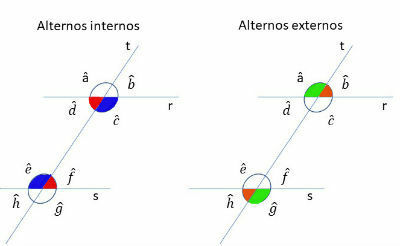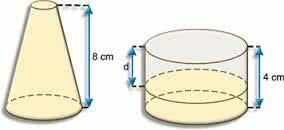Compound rule of three is a mathematical process used in solving questions involving direct or inverse proportionality with more than two quantities.
How to make the rule of three compound
To solve a compound rule of three question, you basically need to follow these steps:
- Check what are the quantities involved;
- Determine the type of relationship between them (direct or inverse);
- Perform calculations using the data provided.
Here are some examples that will help you understand how this should be done.
Rule of three composed with three magnitudes
If to feed a family of 9 people for 25 days 5 kg of rice is needed, how many kg would it take to feed 15 people for 45 days?
1st step: Group the values and organize the statement data.
| People | Days | Rice (kg) |
| THE | B | Ç |
| 9 | 25 | 5 |
| 15 | 45 | X |
2nd step: Interpret whether the proportion between the quantities is direct or inverse.
Analyzing the question data, we see that:
- A and C are directly proportional quantities: the more people, the greater the amount of rice needed to feed them.
- B and C are directly proportional quantities: the more days that pass, the more rice will be needed to feed people.
We can also represent this relationship through arrows. By convention, we insert the down arrow in the ratio containing the unknown X. Since the proportionality is direct between C and quantities A and B, then the arrow in each quantity has the same direction as the arrow in C.
3rd step: Equalize quantity C to the product of quantities A and B.
as all greatnesses are directly proportional to C, then the multiplication of its ratios corresponds to the ratio of the magnitude of the unknown X.
Therefore, 15 kg of rice are needed to feed 15 people for 45 days.
See too: ratio and proportion
Rule of three composed with four magnitudes
In a print shop there are 3 printers that work 4 days, 5 hours a day, and produce 300,000 prints. If one machine needs to be taken out for maintenance and the remaining two machines work for 5 days, making 6 hours a day, how many prints will be produced?
1st step: Group the values and organize the statement data.
| Printers | Days | hours | Production |
| THE | B | Ç | D |
| 3 | 4 | 5 | 300 000 |
| 2 | 5 | 6 | X |
2nd step: Interpret the type of proportionality between the quantities.
We must relate the quantity that contains the unknown with the other quantities. By observing the question data, we can see that:
- A and D are directly proportional quantities: the more printers working, the greater the number of prints.
- B and D are directly proportional quantities: the more days working, the greater the number of impressions.
- C and D are directly proportional quantities: the more hours you work, the greater the number of impressions.
We can also represent this relationship through arrows. By convention, we insert the down arrow in the ratio containing the unknown X. As the quantities A, B and C are directly proportional to D, then the arrow in each quantity has the same direction as the arrow in D.
3rd step: Equate quantity D to the product of quantities A, B and C.
as all greatnesses are directly proportional to D, then the multiplication of its ratios corresponds to the ratio of the magnitude of the unknown X.
If two machines work 5 hours for 6 days the number of impressions will not be affected, they will continue producing 300 000.
See too: Simple and Compound Three Rule
Solved exercises on compound rule of three
question 1
(Unifor) A text occupies 6 pages of 45 lines each, with 80 letters (or spaces) on each line. To make it more readable, the number of lines per page is reduced to 30 and the number of letters (or spaces) per line reduced to 40. Considering the new conditions, determine the number of pages occupied.
Correct answer: 2 pages.
The first step to answer the question is to verify the proportionality between the quantities.
| lines | Letters | Pages |
| THE | B | Ç |
| 45 | 80 | 6 |
| 30 | 40 | X |
- A and C are inversely proportional: the fewer lines on a page, the more pages to occupy all the text.
- B and C are inversely proportional: the fewer letters on a page, the greater the number of pages to occupy all the text.
Using arrows, the relationship between the quantities is:
To find the value of X we must invert the ratios of A and B, since these quantities are inversely proportional,
Considering the new conditions, 18 pages will be used.
question 2
(Vunesp) Ten employees of a department work 8 hours a day, for 27 days, to serve a certain number of people. If a sick employee has been on leave indefinitely and another has retired, the total number of days the employees remaining will take to serve the same number of people, working an extra hour a day, at the same work rate, it will be
a) 29
b) 30
b) 33
d) 28
e) 31
Correct alternative: b) 30
The first step to answer the question is to verify the proportionality between the quantities.
| Employees | hours | Days |
| THE | B | Ç |
| 10 | 8 | 27 |
| 10 - 2 = 8 | 9 | X |
- A and C are inversely proportional quantities: fewer employees will take more days to serve everyone.
- B and C are inversely proportional quantities: more hours worked per day will mean that in fewer days all people are served.
Using arrows, the relationship between the quantities is:
Since the quantities A and B are inversely proportional, to find the value of X, we must invert their ratios.
Thus, in 30 days, the same number of people will be served.
question 3
(Enem) An industry has a water reservoir with a capacity of 900 m3. When there is a need to clean the reservoir, all the water needs to be drained. The drainage of water is done by six drains, and lasts 6 hours when the reservoir is full. This industry will build a new reservoir, with a capacity of 500 m3, whose water must be drained within 4 hours, when the reservoir is full. The drains used in the new reservoir must be identical to the existing ones.
The amount of drains in the new reservoir should be equal to
a) 2
b) 4
c) 5
d) 8
e) 9
Correct alternative: c) 5
The first step to answer the question is to verify the proportionality between the quantities.
| Reservoir (m3) | Flow (h) | drains |
| THE | B | Ç |
| 900 m3 | 6 | 6 |
| 500 m3 | 4 | X |
- A and C are directly proportional quantities: if the reservoir capacity is smaller, fewer drains will be able to carry out the flow.
- B and C are inversely proportional quantities: the shorter the flow time, the greater the number of drains.
Using arrows, the relationship between the quantities is:
As the quantity A is directly proportional, its ratio is maintained. On the other hand, magnitude B has its ratio inverted because it is inversely proportional to C.
Thus, the amount of drains in the new reservoir should be equal to 5.
Keep practicing with the exercises:
- Three Compound Rule Exercises
- Simple Three Rule Exercises
- Rule of Three Exercises
- Exercises on reason and proportion


